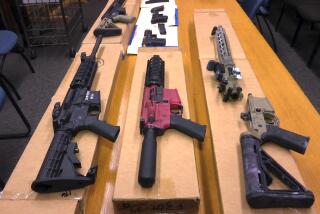Gun ID bill takes a shot at illegal weapons market
- Share via
A proposed state bill requiring all new handguns to be stamped with microscopic identification tags could significantly decrease violence and shut down the illegal gun market if passed, proponents said in a news conference Tuesday.
The Crime Gun Identification Act, AB 1471, would require that lasers be used to create a “microstamp” of each gun’s make, model and serial number that would become imprinted onto shell casings when a bullet is fired. The technology was demonstrated Tuesday by its co-inventor, Todd Lizotte, at the Los Angeles Police Academy.
The microstamp is designed to help law enforcement officials trace shell casings back to a gun’s registered owner, said Assemblyman Mike Feuer (D-Los Angeles), who authored the bill.
Opponents of AB 1471 -- mostly gun lobbyists and the National Rifle Assn., according to Los Angeles Mayor Antonio Villaraigosa -- believe the technology is vulnerable to tampering and does not prevent unlicensed criminals from using the stamped guns.
“These bills come up every year and are under the guise of lowering crime but don’t deal with the criminal element,” NRA spokeswoman Ashley Varner told the Pasadena Weekly in March. “Crime is a human problem, not a gun problem or a bullet problem.”
In letters to Assembly members, the Golden State 2nd Amendment Council wrote that microstamping was “unproven technology” that could cause crime scenes to “easily be contaminated by a criminal throwing down a handful of shell casings he picked up from the local gun range.”
If passed, the bill would take effect Jan. 1, 2010, and would require California manufacturers of handguns to start etching identifying codes inside all guns. The technology license would be given to manufacturers for free, and the process would cost 50 cents to $8 a handgun, experts said.
No other jurisdiction in the United States requires gun stamping, Feuer said. The Assembly passed the bill June 26. The state Senate might vote on the issue next week.
Forensic scientists rely on unintentional marks on bullet casings for identification, but cannot match them to a gun unless the firearm is available, Lizotte said.
“There are hundreds of homicide cases where the only evidence left at the scene of the crime are the bullet casings,” Los Angeles County Sheriff Lee Baca said.
In 2006, 391 of the 481 homicides in Los Angeles involved handguns, said Gary Brennan, deputy chief of the Los Angeles Police Department.
The bill would deter gun owners and retailers from selling to unlicensed purchasers for fear of being tracked by police, Feuer said, drastically reducing the number of armed criminals.
The microscopic, multiple engravings inside each gun make interference nearly impossible, Lizotte said, and even guns that have fired thousands of rounds can still make a clear imprint.
--
More to Read
Sign up for Essential California
The most important California stories and recommendations in your inbox every morning.
You may occasionally receive promotional content from the Los Angeles Times.










